#when he became a villain he lost everything that made him so charming and memorable in the first place
Explore tagged Tumblr posts
Text

JLI Maxwell Lord come back please…
#dc#maxwell lord#when he became a villain he lost everything that made him so charming and memorable in the first place#now he is just another part of wonder woman’s rogues gallery#pardon my editing skills
14 notes
·
View notes
Text
Digimon Adventure: (2020) Final Thoughts
Considering I stopped reviewing this series episode by episode months ago, they’re more positive thoughts than you’d expect, though still not all that positive.
To summarize, this is an entertaining series with plenty of individual good aspects and great episodes that nevertheless leaves me cold as a whole. Much as I enjoyed following it week to week, I can’t say I recommend this series to anyone but hardcore Digimon fans, or hardcore fans of the wider “monster” genre.
Action
It felt appropriate to start with this, considering a focus on action was what the initial interviews promised, and they delivered in spades. It wasn’t perfect or too consistent, there were several times when the Digimon not evolving when they could just broke any tension the fights had, but this series had some of the best fights in any Digimon anime. Anything in the first 3 episodes, Greymon/MetalGreymon vs MetalTyranomon, SkullKnightmon vs Greymon and Garurumon, Mugendramon vs DoneDevimon, Mugendramon vs WarGreymon, Millenniumon vs the dragons, Omegamon vs Abbadomon Core… all of them among the best things the franchise has to offer in terms of action scenes, which after so many series where fights were solved by having a protagonist Digimon evolve and one-shotting the enemy, comes as a breath of fresh air (to be fair, this series also had a lot of that, but it had actual great fights to compensate).
Worldbuilding
Another thing promised in interviews was the use of Digimon from all over the franchise, and not only did they deliver, but they also included plenty of references to the “null canon” to enrich the experience for the most hardcore fans. The series made sure to constantly emphasize the savage nature of the Digital World, bringing back the Tamers worldbuilding of Digimon consuming weaker Digimon in hopes of achieving evolution. Along the way we saw a lot of allies fighting back against this status-quo, from things as overt as Leomon organizing a resistance or Petaldramon protecting weaker Digimon from the all-consuming Entmon, to less dramatic stuff like weak Digimon settling down to live together, or the mere presence of a restaurant where everyone can rest for a while of the hardships of their world.
The biggest flaw here was in how the series handled its antagonists. With very few exceptions, every single enemy Digimon in the series lacked dialog, whereas nearly every single ally Digimon could speak normally, and this disparity cheapened the whole thing, because instead of coming across as “this mentality is normal for this world”, it came across as just your normal “everyone lived together in harmony until the villains attacked”, which is very much not what the series was telling us.
Characterization
That brings us to the next point: the lack of personality for most villains. I joked elsewhere that Minotaurmon from episode 19 was the most compelling villain of the series, and that’s not completely a joke. Almost every single villain of the week was flat, plenty of the “main” villains were lacking in dialog (Algomon in the first few episodes, Nidhoggmon, Millenniumon) or turned mindless halfway through (Devimon, DarkKnightmon). Negamon/Abbadomon in the final episodes managed to benefit from this by being the embodiment of an “instinct”, but in general this meant a mook-of-the-week like Minotaurmon managed to be a highlight among the villains simply by having dialog and non-trivial desires.
But what of the protagonists? The popular opinion is that everyone is far blander than they were in the original series, and I agree. But rather than comparing it with the first series, let’s look at what it had to offer to us. Where in other Digimon series, the backstories and issues of the protagonists and their reactions to what’s going on around them make for most of the drama, in this series the drama comes from the villains trying to destroy everything, and for the most part that means the protagonists only need to be distinct and charming on their own, no necessity to create conflict between them. There is an overall character arc for all of them, though: accepting and interiorizing their new duties towards the world they had ended up stranded on, getting to know and love the Digital World. Was this well done? Not really.
Taichi and Takeru, for example, were so much the embodiment of the stock shonen hero that accepting their place in this new world didn’t really reveal anything about them we hadn’t already seen from their first few appearances.
Jou got stuck as an unfunny punchline 90% of the time, to the point of damaging his few “serious” moments in some of his focus episodes. His development of becoming assertive was compelling in theory, but it got muddled with so many unfunny and uncomfortable hotsprings jokes that the impact was lost.
Hikari started as an even more blatant plot-device “mysterious character” than she was in the original series, before unconvincingly changing to cheerful little girl afterwards (the whiplash between her in episode 33 and her in episode 34 was something else), and only really managing to settle into a compelling character in her last focus episode (58, defending the Digitamas from the Bakemon and SkullBaluchimon, which to be fair is a great episode and probably the best showcase for Hikari as a character in any product or continuity).
Koushiro was mostly fine, although we all remember the several times the series seemed to promise it might do something with him (his uneasiness when his family was mentioned, or that line about having to “face the darkness of his past” in the HerakleKabuterimon episode) that ended up being nothing.
Mimi is the fan-favorite, being charming in nearly all her appearances and having some of the best focus episodes, and it’s mostly deserved. If there’s anything I criticize from her, it’s that her focus episodes don’t really add up to anything.
Yamato was fine, started out as a stock shonen rival before becoming the single most chill “lone wolf” in any Digimon series, probably because of what I said before of the conflict between the protagonists no longer being the source of drama. He gets a slow development of caring only for his brother to starting to care for other Digimon for the sake of Sora and Gabumon to caring about the Digital World just as much as everyone else.
Sora was made fun of by a certain section of the fandom for having the worst focus episodes early on, and I agreed, but having finished the series I can’t get rid of the impression that her focus episodes, while perhaps not that good on their own, when taken as a whole explore her character the best of any other. Yeah, this mostly means exploring her compassion (these are not very multi-dimensional characters), but they deepen and deepen both her impact on the Digimon she saves and how she is impacted in turn by them, moving her away from saving others through her combat prowess to saving others by empathizing with the grief of another caring soul, and by the end I honestly ended up considering her my favorite character (despite none of her episodes making it to my list of favorites).
As for the Digimon… it’s following in the footsteps of other Digimon Adventure products by not really having much of interest for the Digimon themselves except for Tailmon.
Overall, for the most part the main characters were decent, but besides Mimi and ultimately also Sora, I don’t think they’re very memorable. All of them start out promising, but never really improved from that promising start (again, except for Sora).
Pacing
And now we get to the biggest problem of the series: Pacing. I’ve seen it stated elsewhere that this series was more episodic than most (any?) other Digimon series before it, and part of the backlash it got was from not being as serialized as fans expected it to be. This isn’t exactly true. From episode 16 (Eyesmon) to episode 24 (DoneDevimon), this series was as serialized as any other Digimon series has ever been, with nonstop escalation that demanded you keep watching it week after week. Then, from 25 to 35 (Angewomon) or 36 (BlitzGreymon), it pulled slightly back from that never-ending escalation, but was still pretty serialized. It was only afterwards that it became heavily episodic, and by that point it wasn’t expectations set up by previous series that hurt it in the eyes of the fandom, it was expectations set by this series itself in its first half.
Not that the episodes themselves were bad. Honestly, I found myself significantly more entertained by the episodic later half of the series than the serialized first half. Maybe it was because they didn’t feel the need to convince me they were the most exciting, tense thing I had ever seen when they were clearly not (hello, Mamemon episode), or maybe it was that there were more than just endless fights to them, but I normally ended up those episodes entertained and satisfied, whereas with a lot of episodes from Eyesmon to BlitzGreymon, I mostly just felt frustrated after watching them. I agree with the criticism that, when seen as a whole, breaking momentum so hard for so long after months of never-ending escalation wasn’t the right choice, but when seen week after week, I can’t see this change of approach as that bad of a thing.
Conclusion
I think that sums up the series for me. On a weekly basis, it’s pretty entertaining. It’s when seen as a whole that the problems really become clear. There’s been some speculation in the past few weeks of how much the current situation in the world might have impacted the series, but ultimately, I have to judge what actually happened, and I can’t help the impression that this series ultimately left me with nothing of substance after it was all said and done. Like, I enjoyed this more than, say, Appli Monsters, but Appli Monsters have things that stick with you after it’s over. Not so much here, unless you’re a hardcore fan that loves the Omegamon lore this added (which I am, btw; love that Omegamon lore). I don’t think I can recommend this series to anyone who isn’t a hardcore Digimon fan, or at least a hardcore fan of the wider “monster” genre.
One thing I’m grateful to this series for, though, it’s the commercial boost it has given the rest of the franchise. I’m not going to credit it for all the successes it currently has, after all the Card Game would have fell off by now if it wasn’t genuinely well-done and the Vital Bracelet happened because of years of the virtual pet division progressively building up its audience after it had nearly died off, but it’s undeniable they wouldn’t have sold as well without this anime advertising the franchise week after week. Next week, we’ll have the first episode of Digimon Ghost Game, the first time since 2001 that we have a Digimon series being immediately succeeded by another. If that isn’t a sign of how well the franchise is doing right now, I don’t know what is.
Favorite Episodes: 1 (Tokyo Digital Crisis), 6 (The Targeted Kingdom), 12 (Lilimon Blooms), 20 (The Seventh One Awakens), 32 (Soaring Hope), 42 (King of Inventors, Gerbemon), 49 (The God of Evil Descends, Millenniummon), 56 (The Gold Wolf of the Crescent Moon), 58 (Hikari, New Life)
7 notes
·
View notes
Text
Kamen Rider Gaim Episodes 01-20
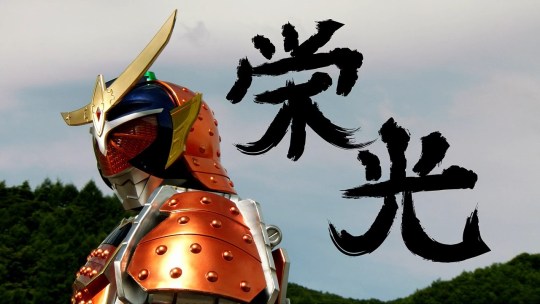
Also known as Kame Rider Fruits Salad edition.
It's time for more past rider action as I start my fifth season in this series. I honestly don't know how I'm still doing this, but I'm glad that despite my schedule problems I'm sticking with this journey because this season is a good one.
I was very excited to see this, not just because my experience with Wizard was very positive, but also because I've seen images and gifs being retweeted in my timeline and everything seemed so ridiculous I couldn't wait to experience all of that by myself, and I gotta say, they delivered! (different from that other season I saw people being so passionate about but that I disliked with passion)
And this is something funny because I have quite a lot of things about Gaim that bug me and that should make me dislike it, but even still I can't help but like this season a lot. Gaim has a certain magnetic charm to it that I don't know how to explain, putting in terms of the show I'm like the Inves and Gaim is the evil fruit of the forest taking control of my brain. This show is so entertaining that if I was able to sit down for 72 hours without being interrupted and not needing to do my physical necessities I'd definitely spend those hours watching Gaim, I'm not joking, I had to force myself to stop watching it a couple of times because if it was up to me I would sit down in front of my laptop and leave after the show ended.

And I feel like a huge part of what makes me so interested on Gaim is this mystery feel it has to it, I wanna know where all of this is gonna go so it makes me more interested on watching more and more to see the secrets being revealed and all of that. Add a whole lot of great cliffhangers and the fact this series doesn't seem to follow the "2 episodes, 1 story" format and you make for a show that has a very good pace and that makes it feel like no episode here is filler or unnecessary.
But this is a double-edged sword because while the mystery vibe is great I feel like the show held a whole lot of information at the beginning which made it hard for me to understand this world, and understand these characters. Why is dance so important here? Why do these dance teams exist and why are they fighting each other? When did those lock seeds start appearing? And why are they in the kids' hands? What's Kouta's relation to this dance crew? Why is there a ranking for dancing crews? Why is all of that so important for these characters I'm gonna follow? I watched 20 episodes, still, I feel like I don't know any of the characters very well because neither of them had a very good base for me to have a feel of who these characters are. Which makes it harder for me to connect because I don't feel what the characters are feeling, my experience with Gaim is a very "external" one, I'm watching it and I'm enjoying it a lot but I'm not emotionally invested, I think that's the best way to put it.

Speaking of characters, another thing that I feel like it makes it harder to know all characters is the fact that THERE ARE A LOT OF THEM. No joke, I don't know any of their names and the only Rider name I have memorized is Gaim because of obvious reasons, the way I have to connect the characters to their faces is by their main fruit, which solves things for the characters that are Riders but the side characters that don't they literally have no name for me, any given name you see in this post is because I opened the wikia and went to look for the names. This is a very crowded season.

Kouta as a protagonist gives me a lot of mixed feelings. I overall like him, but that are times where the show makes me want to hate him, but I guess that's just how teenagers so the show has perfectly hit the nail on him. I like how he starts as a good kid trying to get a job to help support his family, but then he becomes a rider and that gets up to his head and he becomes an overconfident prick just to have his ass kicked down and throw him on a downward spiral where he "refuses the call" to then have a moment where he slowly rises again, and even in this escalation he gets doubtful in quite a lot of times showing that he's a very interesting character. I only wish we knew more basic stuff about him, or at least have glimpses of his past, to know where did he came from and be able to have an estimative of where he's going to.

Sadly the other characters aren't anywhere near being this interesting. Kaito is just the hot-blooded rival, they decided to give him a backstory about he being anger at Yggdrasil for taking over the city but I think it only made him look more like just a teen with anger management issues rather than a compelling character. Mitchy had potential with the whole thing of being a kid from a rich family that has no freedom in regards to his future, but he more or less always followed the things I expected him to do as a character in his position so it was just a little boring. Near the end of this batch, Zack became a rider too but he's such a background character I have nothing to say about him. Junouchi and Hase lacked in personality because they were sold as a duo and they barely did anything on their own, Hase at least got more interesting things going for him since he eventually ate a fruit and died as an Inves what made him interesting where Junouchi just ended up being the keychain of another rider... and oh boy, Oren... it's kinda hard to talk about him. I'm not sure if "gay coded" is the correct term for him, probably not, but the thing is he's very problematic. First, because the show kinda sits in with Kouta's point of view and since the first meeting Kouta already showed signs that he didn't like him and that it was weird for him to see a flamboyant man with feminine trajects and he was always negative towards him. Then the show makes him be a Team Rocket villain where his character gets downed to a single goal and objective and every time he gets up on the screen is for him to be made fun of and it just makes me wanna hit my head on the wall. I know I shouldn't be surprised since last season they had the manager of Hungry Donuts that was also an LGBTQ+ character being used for comedic purposes, but at least in there, there was no portrayal of any character of the cast being uncomfortable or hostile against her so she was never seen with bad eyes or had any negative association to her (they also had a trans actor play her role which is an added bonus even though she wasn't out yet during the time of filming).
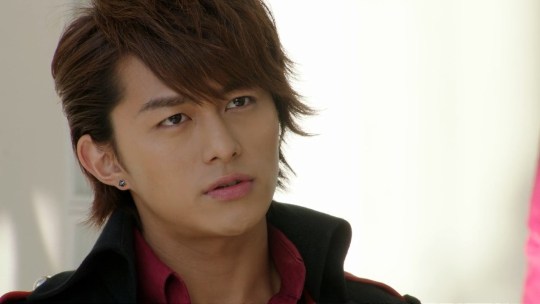
The show also has a "second set" of riders that are the adults on Yggdrasil's side. I feel like I don't have a lot to say about them because they were in the backseat a lot during the season and only started to have a more active role on screen now so I still don't have an opinion on them. Takatora seems bland, Sid was the one of this team that had more screen time but I also don't have an opinion on him, he's just like a drug dealer there's nothing special about him other than he uses one of my favorite fruits in his rider form. Ryoma and Yoko are probably the more interesting characters from this team and I'm really excited to see more of them.
There are more characters of this cast but I don't like any of them all that much so I won't spend more time talking about them, I'll talk briefly about the Riders' designs because this post is already long enough.
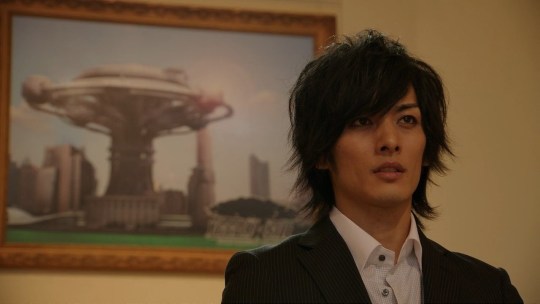
To begin with, I think it's a genius idea of mixing fruits with samurais for the main motifs of the riders, it's such a ridiculous, wild, and creative idea I wish I could be friends with whoever imagined this concept. I pretty much like all of the suits, I think the only form I don't like it's the Jimba Lemon one because it's not very aesthetically pleasing, it doesn't match very well with Gaim's basic design so it doesn't look as good to me, but I also don't like the giant watermelon suit, probably because the CGI looks weird, but I still don't like it. I love how the belts are very simple, it's a good contrast with the overly designed suits, I wish they had kept that simplicity for the genesis drivers as well. If I had to choose my favorite designs they are Gaim's strawberry, Baron's mango, Zangetsu's melon, Duke's lemon, and Marika's peach forms.
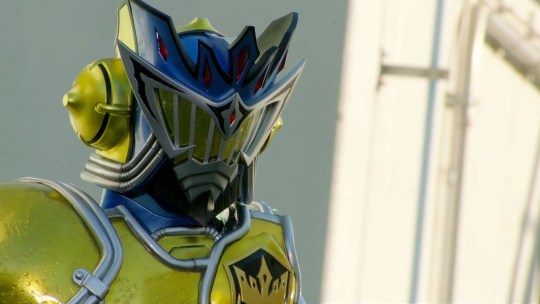
Before I wrap up this post I have two final complaints about this whole thing. The first one is the fact I don't know what's the message the show is trying to convey. Right at the beginning, I thought it was about growing up, but that was never touched again so I'm not sure if it's that, you know? The show feels a little lost in this aspect. It is a nice story, don't get me wrong, but all stories so far had a theme and I couldn't really find the theme on this one yet. I hope that after the reveal that the forest is like a parasite they'll bring up discussions that'll highlight what this is story is about.

My other problem is how against adults the show is. Maybe if I had watched this in my teenage years I'd be more in synchrony with the point of view of adults are liars and they're a problem, but now as an adult, I know that things aren't so simple. While I agree that using kids to gather data for their experiments wasn't the right course of action, I don't like how the protagonists are always so keen on being against adults and everything. Maybe they're like this because of how Japanese society is and to them becoming adults is like losing the sense of their own identities so to them adults are really like villains, but I still think that they hit too much on this key and it's kinda hard to watch without rolling my eyes at certain points.
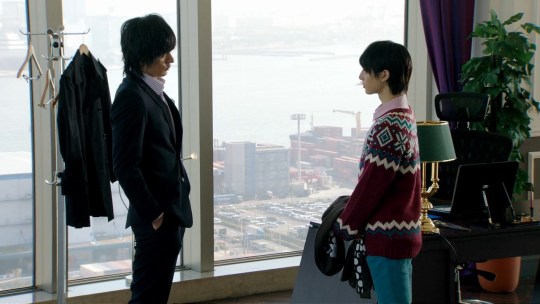
With that being said, I still enjoyed the hell out of this show and I'm very excited to continue. So, what are your thoughts about Gaim, let me know down in the comments. I'll catch up with you folks later.
4 notes
·
View notes
Text
Spiderman: Into the Spider-Verse Review
Spider-Man crosses parallel dimensions and teams up with the Spider-Men of those dimensions to stop a threat to all reality.
With having six films under his belt as well as two other appearances in the Marvel Cinematic Universe, you might be forgiven in thinking Spider-Man on film had explored all it could, especially when those films have already seen two fresh reboots of the wall-crawler’s origin. Spidey’s first foray into animated features, however, gives both mainstream audiences and Spidey fans something incredibly fresh with Spider-Man: Into the Spider-Verse. The film embraces everything great about Spider-Man, acting as a love-letter to the character and what he represents with the inclusion of fan-favourite Miles Morales and several other Spider-men and women. Its a vastly entertaining and heartfelt film with an outstanding visual quality that looks like a comic book brought to life.
Rather than focus entirely on Peter Parker, Into the Spider-Verse wisely chooses to place the spotlight on Miles, a relatively new character to the franchise who became a new Spider-Man in an alternate universe. Miles helps give the film that refreshing feeling as the story focuses on him, his family and origin into Spider-Man. He’s a very relatable and easy character to root for as the story follows his search for identity and what makes him so special in the Spider-Man mythos. This success is due in part to Shameik Moore’s portrayal of Miles. Moore does a great job of giving Miles a youthful vulnerability and shares great chemistry with Jake Johnson’s alternate Parker and Hailee Steinfeld’s Spider-Gwen. For any fans who have only known the Parker version of Spidey, the film makes it very easy for audiences to invest in Miles as a character and his development throughout the story.

When it comes to Spider-Man proper, the film takes some very risky choices with Peter Parker. Unlike the Spider-Man of Miles’ world, the alternate Spider-Man that gets zapped across dimensions is an older, disheveled and disillusioned man who has lost nearly everything, including his will to fight. It’s a very new take on Spidey, but one that ultimately pays off as it puts the character in an entirely new state of mind. Johnson conveys the weariness and regret of this Spidey well, yet still retains his wit and charm even if it is mostly for show. It also allows for a bit of a deconstruction on Spider-Man and why he has remained such a popular superhero for nearly 60 years, examining his tendency to bounce back and refuse surrender despite the curves life throws at him.

The rest of the cast do very well in their roles. Steinfeld is great as Spider-Gwen and relishes every moment of the hero’s big screen debut while Nicolas Cage and John Mulaney deliver some of the film’s funniest moments as Spider-Noir and Spider-Ham respectively. Kimiko Glenn’s anime-inspired Peni Parker wasn’t quite as memorable as the other alternate Spideys and could have been a bit more fleshed out, but she still delivered some funny moments and cool sequences in the fights. On the villainous front, Kathryn Hahn made for a very fun new take on Doctor Octopus while Liev Schreiber gave a worthy performance as Wilson Fisk, aka Kingpin. As the main antagonist of the story, Into the Spider-Verse gives Kingpin a motivation that doesn’t revolve around ruling the world or dimensions and instead goes for something much more human and emotional. However, the emotion for Kingpin’s motivation does lack some depth as its presented on a very superficial level. A little more exploration into Kingpin would have been welcome.

The story moves along at a nice pace, taking the time to let the audience sit with Miles’ emotions during some of the quiet scenes as he’s thrown for loop after loop. Events in the film feel pretty organic and aren’t rushed, giving a nice balance of the film’s emotional and serious tones with its comedy. Into the Spider-Verse is absolutely hilarious with so many of the jokes or slapstick moments sticking the landing. None of it feels like its too much, but comes naturally and at the right places where the film calls for the characters and audiences to breathe a little. It also boasts some of the best action in a Spider-Man film that is very easy to follow and incredibly fluid. With so many Spidey characters, it could have been difficult to portray all their abilities, but they all move so well in some very well-choreographed and animated action sequences. The combination of the film’s fun atmosphere and tension is mixed well-together, especially during its memorable climax.

Into the Spider-Verse is also unique among the animated genre for how it presents its animation. The film’s visuals are gorgeous, from the how the action is depicted to the mix of colours, the visual palette is full of vivid imagery. It even goes the extra mile to include thought boxes, words splashed across the screen or written sound effects to separate itself from other animated fare by embracing its comic heritage. The details of the characters themselves draw a lot of individual attention, such as the way Spider-Nior appears grainy or Peni’s cell-shaded look to emphasize her anime roots. The film really does look like a comic book brought to life.

Spider-Man: Into the Spider-Verse is a celebration of all things Spidey throughout his publication history. Directors Bob Persichetti, Peter Ramsey and Rodney Rothman know exactly what to focus on by making Miles the star, yet still examining why Spidey has remained so prevalent in pop culture. Its visuals are stunning and action quite entertaining and memorable, but the full emphasis is placed on the story and characters instead of just simply moving the plot from A to B to keep it going. Whether you’re a casual fan or really into Spidey, Into the Spider-Verse is highly entertaining and enjoyable.

0 notes